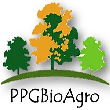Banca de QUALIFICAÇÃO: FABIANA WINK
Uma banca de QUALIFICAÇÃO de MESTRADO foi cadastrada pelo programa.DISCENTE : FABIANA WINK
DATA : 25/06/2024
HORA: 08:00
LOCAL: Unidade II, Campus DE Alta Floresta
TÍTULO:
EXTRACTS OF Apeiba tibourbou Aubl. CAN THEY BE A SUSTAINABLE ALTERNATIVE FOR THE CONTROL OF Spodoptera frugiperda (J. E. Smith) (Lepidoptera: Noctuidae)?
PALAVRAS-CHAVES:
Vegetable insecticides; Defoliating caterpillar; Secondary metabolites; Polar and non-polar solvents.PÁGINAS: 60
GRANDE ÁREA: Ciências Agrárias
ÁREA: Agronomia
SUBÁREA: Fitossanidade
ESPECIALIDADE: Entomologia Agrícola
RESUMO:
Brazil stands out as a major agroforestry producer and therefore, the larger the planted area, the greater the damage caused by insect pests in plantations, among which the Spodoptera frugiperda caterpillar can be highlighted. Considering the growing increase in phytosanitary products used in plantations to control different species of insect pests, in order to avoid risks to human health and the environment, studies with plant insecticides have been increasing. Among these plants with insecticidal potential, Apeiba tibourbou stands out, belonging to the Malvaceae family, which occurs in tropical regions of South and Central America and in Brazilian territory in the Amazon, Cerrado, Caatinga and Atlantic Forest regions, popularly known as pente de macaco. This species presents a great diversity of secondary metabolites with a variety of chemical compounds that act in the defense mechanism against herbivory, such as steroids, terpenoids, alkaloids, saponins as well as phenolic substances, such as tannins and flavonoids. Therefore, this work presents two chapters, the first evaluates the bioactivity of hydroethanol extracts from the leaf and bark of Apeiba tibourbou in different concentrations on Spodoptera frugiperda in contact and ingestion bioassays. Hydroethanolic extracts of the leaf and bark were prepared at concentrations of: 0, 2, 4, 6 and 8%, and mortality was evaluated in 72 hours and at the end of the larval period, caterpillar weight, pupa weight, larval time and pupal. It was observed that the extracts had significant effects on the duration of larval and pupal time, causing the lengthening of these phases, and presenting a mortality of 50% of Spodoptera caterpillars in the highest concentrations at the end of the larval period. In the second chapter, the toxicity of extracts produced with different solvents of Apeiba tibourbou on Spodoptera frugiperda was analyzed. For this purpose, different solvents were used to prepare the leaf and bark extracts: hexane, acetone, ethyl acetate and methyl alcohol in a bioassay of Ingestion with an artificial diet and a natural diet with cabbage (Brassica oleracea). It was observed in the bioassays that there was a greater mortality of the caterpillars when they were subjected to hexane-based extracts and these also interfered with the development of the caterpillars. Thus, the species Apeiba tibourbou presents itself as a promising species for controlling Spdoptera frugiperda.
MEMBROS DA BANCA:
Interna - 253817001 - JULIANA GARLET
Interno - 70141009 - OSCAR MITSUO YAMASHITA
Externa ao Programa - 257913001 - ADRIANA MATHEUS DA COSTA DE FIGUEIREDO
Externa à Instituição - LAURA ARAUJO SANCHES - UFMT



